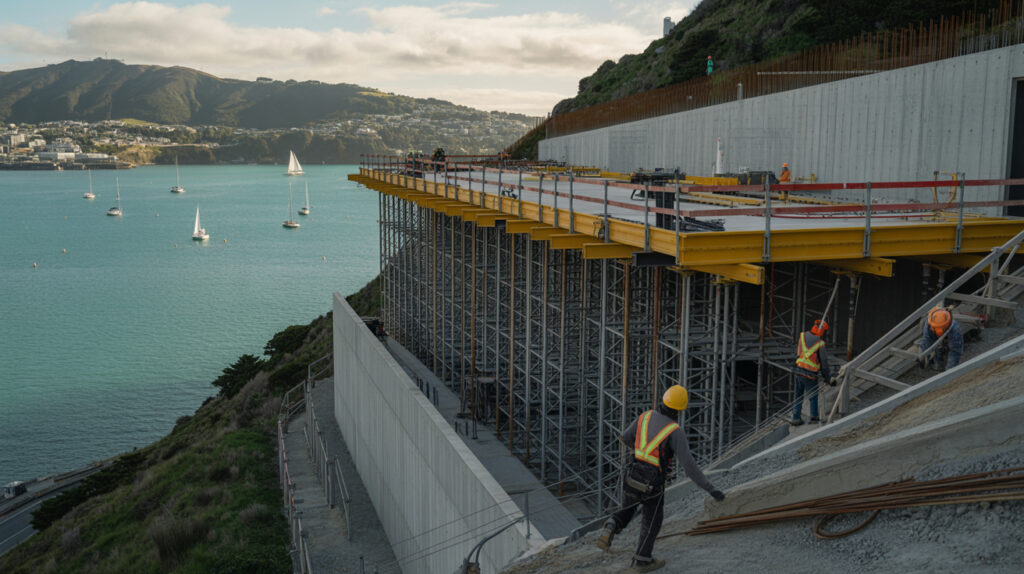Wellington, New Zealand’s capital, is renowned for its stunning harbour views, vibrant culture, and its dramatic, undulating landscape. This “windy city” is built on a series of steep hillsides, creating a unique urban tapestry that is as beautiful as it is challenging for construction. Building in Wellington isn’t just about putting up walls; it’s a testament to human ingenuity, demanding a deep understanding of specialized engineering and innovative construction techniques to defy gravity and conquer the city’s formidable hillside terrain.

The Undulating Canvas: Understanding Wellington’s Geotechnical Landscape
Before a single shovel breaks ground, a comprehensive understanding of Wellington’s complex geology is paramount. The city sits in an active seismic zone, with underlying fault lines and a history of significant earthquakes. The soil itself is highly variable, ranging from stable bedrock to less predictable clay soils and loose fill. This necessitates extensive geotechnical investigations and detailed site analysis to determine the ground’s stability, bearing capacity, and potential for liquefaction or slippage, especially during seismic events.
Laying the Groundwork: Foundation Solutions for the Slopes
The steeper the slope, the more critical and often creative the foundation solution becomes. Unlike flat land where conventional shallow foundations suffice, Wellington’s hills demand robust and often bespoke approaches.
- Piled Foundations: This is a common solution, involving deep piles driven or bored into the ground until they reach stable bedrock or a suitable bearing stratum. These piles act like stilts, transferring the building’s load deep into the earth. Variations include bored piles, driven piles, and screw piles, chosen based on soil conditions and structural loads.
- Retaining Walls as Integral Foundations: In many cases, retaining walls aren’t just for holding back earth; they become an integral part of the building’s foundation. These substantial structures, often constructed from reinforced concrete, timber, or a combination, bear significant vertical and lateral loads. They can be designed as cantilevered walls, gravity walls, or anchored walls, often incorporating complex drainage systems to prevent hydrostatic pressure buildup.
- Stepped Foundations: For less extreme slopes, foundations can be “stepped” down the hillside, following the natural contour. This minimizes excavation and earthworks, but requires careful structural design to ensure even load distribution and prevent differential settlement.
- Cantilevered Structures: Architects often leverage the steep slopes to create striking cantilevered designs, where parts of the building extend outwards, seemingly floating above the terrain. These require exceptionally strong structural frames and deep, well-anchored foundations to counteract the cantilevered forces.
Also Read: Quality Over Quantity: High-Value Residential & Lifestyle Builds in Marlborough
Taming the Earth: Retaining Walls as Art and Engineering
Retaining walls are not mere necessities in Wellington; they are often prominent architectural features, seamlessly blending with the landscape while performing a vital engineering role. The choice of retaining wall material and technique depends on a multitude of factors, including the height of the retained earth, soil type, site access, and aesthetic considerations.
- Reinforced Concrete Retaining Walls: These are the workhorses of Wellington’s hillside construction. Poured concrete walls, often with integrated steel reinforcement, offer exceptional strength and durability. Shotcrete, or spray concrete, is also increasingly used for stabilizing unstable banks and slips, allowing for intricate shaping and quick application in difficult-to-access areas.
- Timber Pole Retaining Walls: For a more natural aesthetic, particularly on residential properties, timber pole walls are popular. Treated timber sleepers are stacked and secured, often with backfilling and adequate drainage. While aesthetically pleasing, their design must account for the forces exerted by the retained earth and the lifespan of the timber in Wellington’s climate.
- Gabion Walls: These innovative walls consist of wire cages filled with rocks. They are permeable, allowing water to drain through, which reduces hydrostatic pressure. Gabion walls are known for their flexibility, durability, and natural appearance, making them suitable for erosion control and challenging drainage areas.
- Soil Nailing and Anchoring: For large-scale excavations or stabilizing existing slopes, soil nailing involves drilling steel bars into the ground and grouting them in place, then covering the face with shotcrete or a facing material. Ground anchors are another technique, where tensioned cables are installed into the ground to provide additional stability against sliding or overturning forces.
The Access Conundrum: Logistics on Steep Slopes
One of the most significant, and often underestimated, challenges of building on Wellington’s hills is site access. Narrow, winding roads, steep driveways, and limited space for maneuvering large machinery can add substantial complexity and cost to a project.
- Specialized Equipment: Standard excavators and cranes often can’t reach the tight spaces or extreme inclines. This necessitates the use of smaller, specialized machinery, spider excavators, or even helicopter lifts for transporting materials and equipment to inaccessible sites.
- Material Handling: Getting building materials to the construction zone often involves creative solutions. This might include using small all-terrain vehicles, temporary cableways, or manual labour for smaller, lighter components. Careful planning of material delivery and storage is crucial to avoid bottlenecks and ensure efficiency.
- Worker Safety: Working on steep and uneven terrain presents inherent safety risks. Rigorous safety protocols, including specialized harnesses, fall protection systems, and comprehensive training, are essential to protect the workforce. The dynamic nature of the site, with potential for loose debris or slips, requires constant vigilance.
- Neighbourhood Impact: Construction on steep sites often takes place in established residential areas. Minimizing disruption to neighbours, managing noise and dust, and ensuring the safety of public access routes are critical considerations.
Beyond the Build: Sustainable Practices and Future Challenges
As Wellington continues to grow, the demand for hillside development will only increase. This brings with it a greater emphasis on sustainable building practices. Minimizing environmental impact, managing stormwater runoff, and incorporating green infrastructure are becoming increasingly important. Innovative approaches like prefabricated construction, which can reduce on-site waste and construction time, are also gaining traction.
The “vertical challenge” in Wellington is not just a phrase; it’s a daily reality for engineers, architects, and builders. It’s a testament to their dedication to pushing the boundaries of construction, transforming challenging topography into architecturally significant and resilient homes that stand proudly against the city’s iconic skyline. Mastering this vertical challenge requires a blend of advanced engineering, innovative techniques, and an unwavering commitment to safety and collaboration, truly shaping the unique character of Wellington.
